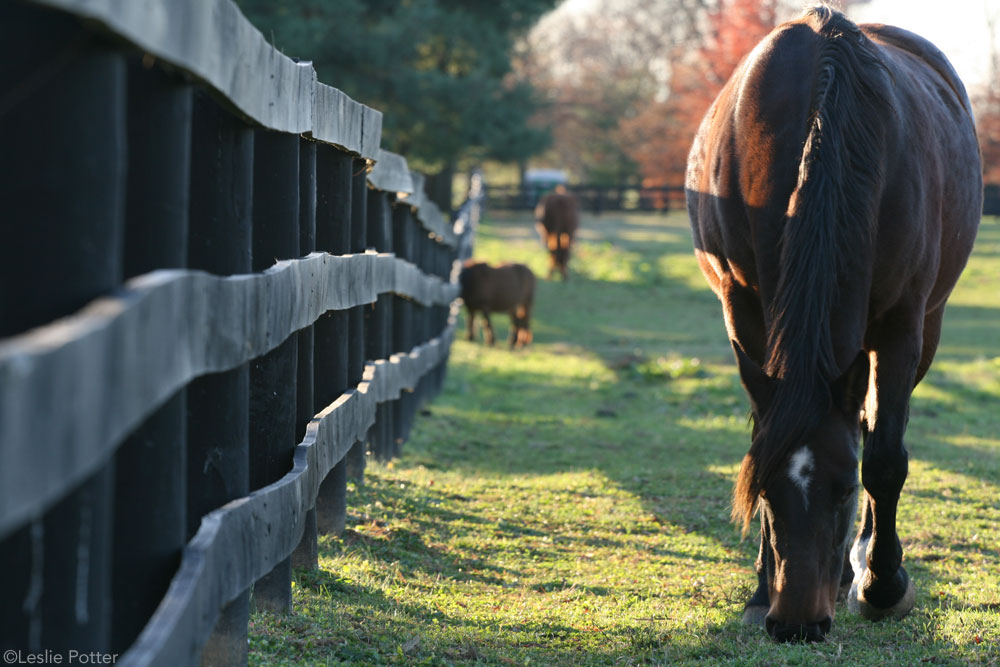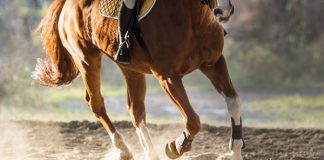In these cooler fall months, a bit of rain and a burst of the last remaining summer warmth can cause a growth spurt in your pasture. This sudden increase in rich grass can put your horse at risk for founder in the fall. Here are some tips to prevent this seasonal problem.

A sudden influx of large amounts of rich grass can wreak havoc on a horse’s metabolism, as sugar from the grass, called fructan, triggers inflammation in the laminae of the hoof, which is the sensitive Velcro-like structure on the inside of the hoof that attaches the hoof wall to the coffin bone. The coffin bone is the triangular bone inside the hoof, also called P3 which is short for the third phalanx.
During this inflammation, which is very painful, the laminae begin to die. This weakens the connection between the hoof wall and the coffin bone. If the inflammation is bad enough, the coffin bone will begin to separate from the hoof wall and rotate down toward the sole.
Understandably, it becomes very hard for a horse to stand and walk with this condition. A horse with founder will often lean back on his heels to get the weight off his toes, which is where the laminae hurt the most. When he walks, a foundered horse’s gait will look like he’s walking on eggshells as he carefully moves his painful feet.
A foundered horse’s hooves are usually warm or hot to the touch and in many acute cases, you can feel a strong, bounding pulse along the artery that runs up the fetlock.
Since preventing founder is far more desirable than managing it after it happens, keep a close eye on your horse’s pasture as the summer wanes. If you notice greener grass in the field seemingly overnight instead of the parched, dust bowl stereotypic of the dog days of summer, here are some ways to decrease your horse’s pasture intake.
Strip grazing.
If you have access to electric fencing, strip grazing is an easy method to allow your horse some limited pasture time in the face of fall re-growth.
Grazing muzzle.
These muzzles attach to a horse’s halter and allow only a few blades of grass to be eaten at a time, greatly decreasing your horse’s consumption when at pasture.
Dry lot management.
Sometimes simply limiting your horse’s time out at pasture is the best way to restrict his grass intake. One or two hours at a time may be all that he needs at first to get accustomed to new grass growth. The remainder of the day can be spent in a dry lot with hay. The period on pasture can then slowly increase.
In addition to keeping an eye on the grass, also closely monitor your horse’s hooves. Horses that have had laminitis in the past, those that are overweight or are easy-keepers, and those known to have insulin resistance should in particular be closely monitored during bouts of pasture re-growth in the fall. Regularly examine the following aspects:
Your horse’s body weight.
Although using a weight tape is a rough estimate of body weight, this measurement at least gives you an objective number with which to compare subsequent measurements. Weight taping your horse once a month throughout the spring and fall is a good guide to keep an eye on any weight gain as a result of lush pasture.
Hoof temperature.
Whenever you bring your horse in for riding or grooming, take a minute to feel his hooves. Prior to riding, note their temperature. Unless the horse has been standing in the sun—or has just been ridden or running around the field—his hooves should be cool to the touch. Hot hooves when a horse is at rest is an indicator of laminitis.
Digital pulse.
Routinely feel for your horse’s digital pulse, which is the pulse that runs in the digital artery between the fetlock and the coronet band. Remember that all horses have a digital pulse; you are feeling for the pulse’s quality, not presence. A foundered horse will have an extremely strong digital pulse, referred to as a bounding pulse.
Your horse’s movement.
Watch you horse in the field. When he walks, his gait should be free and relaxed. If you notice him walking delicately on his feet, leaning back on his heels, or even laying down more than normal, these could be warning signs that his feet hurt from founder.
One final note on fall founder: if you suspect your horse has founder, call your vet immediately. Don’t wait to see how your horse feels in the morning or the next day. Time is of the essence when treating inflamed laminae. As you wait for your vet to arrive, apply cold water via hose directly to your horse’s hooves or have your horse stand in an ice bath.
With conscientious monitoring of both your horse’s pasture and his hooves, you will be in good shape to prevent this painful condition no matter what the season.
Liked this article? Here’s more info on founder:
Ask the Vet: Preventing Laminitis
Preventing Grass Founder
First Aid for Laminitis






great info
Please..differentiate, lamintis from founder! A horse can experience laminitis, and not founder!
Great advice.
That was very helpful.Thank you for the Great advice